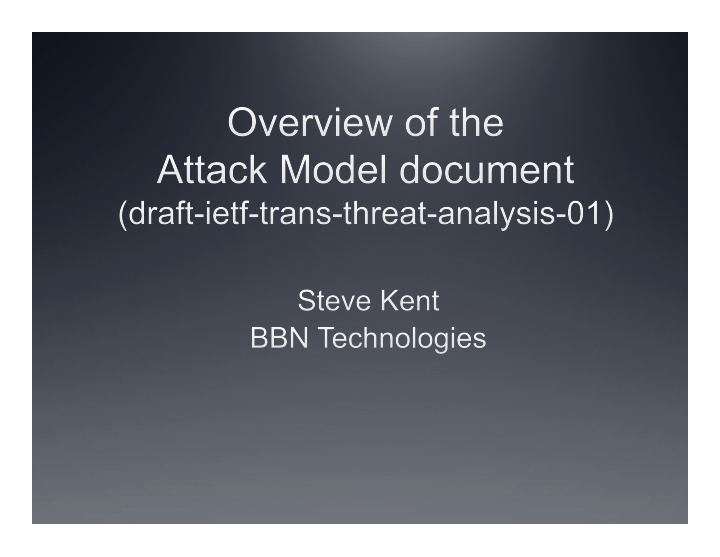



Purpose The goals of this document are Provide an introduction to CT (more appropriate for an architecture document, but … ) Define “mis-issuance” Establish a taxonomy of attacks in the CT context, by examining scenarios based on benign and malicious CAs, as well as benign and mis-behaving logs and Monitors Examine the impact of various classes of attacks, in various scenarios, in terms of CT goals 2
Document Outline Introduction Semantic mis-issuance Syntactic mis-issuance Issues applicable to Sections 2 & 3 3
Concise CT Goals Statement Certificate transparency (CT) is a set of mechanisms designed to detect, deter, and facilitate remediation of certificate mis-issuance Monitoring of logs provides detection Logging provides deterrence Certificate revocation, triggered by Monitoring, effects remediation 4
Semantic Mis-issuance The fundamental semantic constraint for a certificate is that it was issued to an entity that is authorized to represent the Subject (or Subject AlternativeName) identified by the certificate. It is also assumed that the entity requested the certificate from the CA Semantic mis-issuance yields a “bogus” certificate 5
Syntactic Mis-issuance A certificate is characterized as syntactically mis-issued if it violates syntax constraints associated with the type of certificate that it purports to represent. Syntax constraints for certificates are established by certificate profiles, and typically are application-specific. Examples: EV & DV certificates, S/MIME IPsec, … 6
CT Beneficiaries Subjects – benefit by having bogus (logged) certificates detected and revoked, thus preventing prolonged spoofing of the Subject’s web identity RPs (browsers) – benefit by rejecting bogus certificates, relying on a revocation mechanism (CRL, OCSP, or browser-vendor blacklists), after a bogus certificate has been detected 7
Herd Immunity? All Subjects may benefit from CT, even Subjects that do not have SCTs for their certificates, if the Subjects’ names and public keys are monitored All RPs may benefit, even if they do not discriminate against certificates w/o SCTs, because they are protected against bogus certificates via revocation 8
Monitors Two types: self monitoring or 3 rd party Provisioned with reference information for the set of Subjects being protected List of Subject names (or SANs) List of public keys associated with each name Acquires log entries and looks for conflicts with Subject reference info Rely on the Audit function to detect misbehaving logs 9
Attack Taxonomy Semantic & Syntactic mis-issuance Benign vs. malicious CAs Certificate logged vs. not logged Benign vs. misbehaving logs Self-monitoring and benign 3 rd party Monitors vs. misbehaving Monitors “Careful” browsers vs. vanilla browsers 10
The Role of Auditing The primary purpose of auditing is to detect misbehaving logs, so that Monitors will not rely on them A log misbehaves if it Fails to meet its published MMD Fails to log a certificate for which it has issued an SCT Provides different Merkle tree data to different clients (e.g., to hide log entries from Monitors) 11
Section 4 Topics Subject selection of Monitors to ensure “adequate” coverage of logs Monitor discovery & selection of logs, especially for self-Monitors Browser behavior: incremental deployment vs. missing SCT hard failure Remediation for malicious CA behavior Auditing issues 12
Auditing Challenges To preserve privacy, the Audit function must not disclose information about which sites a browser visits, except to entities trusted by the browser user To detect log misbehavior an Auditor needs access to log replies sent to different clients, while preserving privacy The audit mechanism must support potentially tens of millions of (self) Monitors 13
Going Forward I’ve received comments from only a few individuals; I’ve made changes in response to those comments We need WG agreement (via the list) on CT goals Definitions of mis-issuance Functional characterization of Monitors and Auditing Details of the attack model & implications for CT secruity 14
Q U E S T I O N S ? 15
Recommend
More recommend